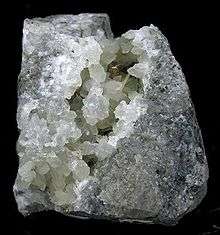Krennerite
| Krennerite | |
|---|---|
|
Krennerite from the Cresson Mine, Cripple Creek, Colorado (about 5 mm). | |
| General | |
| Category | Telluride mineral |
| Formula (repeating unit) | AuTe2 |
| Strunz classification | 2.EA.15 |
| Crystal system | Orthorhombic |
| Crystal class |
Pyramidal (mm2) H-M symbol: (mm2) |
| Space group | Pma2 |
| Identification | |
| Formula mass | 453.2 g/mol |
| Color | White to blackish yellow |
| Crystal habit | Massive to crystalline |
| Cleavage | Perfect |
| Fracture | Conchoidal |
| Mohs scale hardness | 2.5 |
| Luster | Metallic |
| Streak | greenish grey |
| Diaphaneity | opaque |
| Density | 8.53 |
| Optical properties | Anisotrophic |
| Pleochroism | weak |
| Ultraviolet fluorescence | None |
| References | [1][2] |
Krennerite is an orthorhombic gold telluride mineral which can contain a relatively small amount of silver in the structure. The formula is AuTe2 varying to (Au0.8,Ag0.2)Te2. Both of the chemically similar gold-silver tellurides, calaverite and sylvanite, are in the monoclinic crystal system, whereas krennerite is orthorhombic.
The color varies from silver-white to brass-yellow. It has a specific gravity of 8.53 and a hardness of 2.5. It occurs in high temperature, hydrothermal environments.
Krennerite was discovered in 1878 near the village of Săcărâmb, Romania, and first described by the Hungarian mineralogist Joseph Krenner (1839–1920).
See also
References
- G. Tunnell and K. J. Murata, American Mineralogist 35, 359-384 (1950).
- Structure of Krennerite retrieved 6-26-05
- Euromineral retrieved 6-26-05

Krennerite in a quartz vein, Cresson Mine, Cripple Creek, Colorado. Specimen size 3.0 x 2.7 x 2.5 cm. See infobox for detail photo.
| Wikimedia Commons has media related to Krennerite. |
This article is issued from Wikipedia - version of the 11/19/2016. The text is available under the Creative Commons Attribution/Share Alike but additional terms may apply for the media files.
